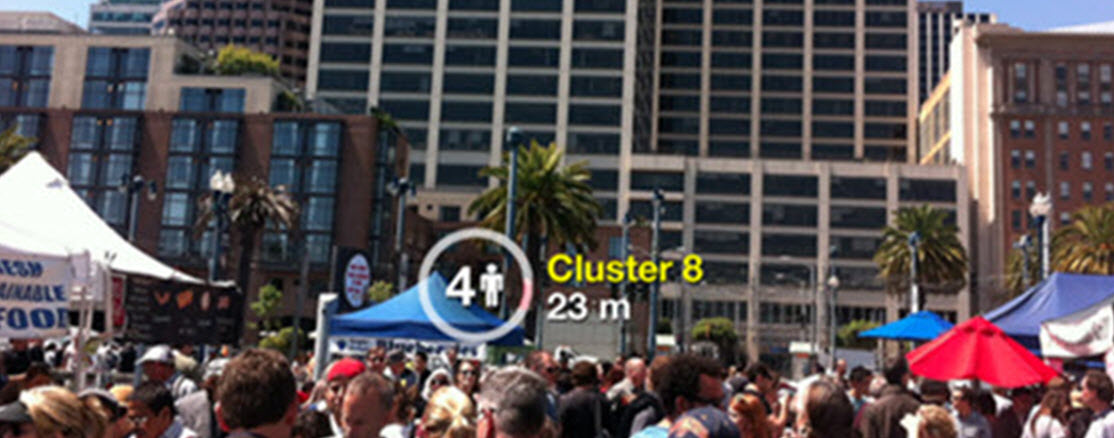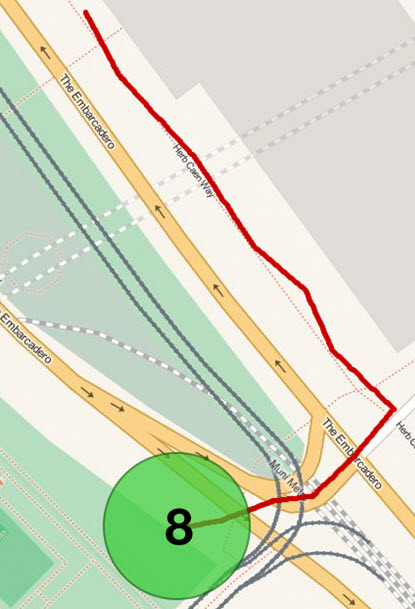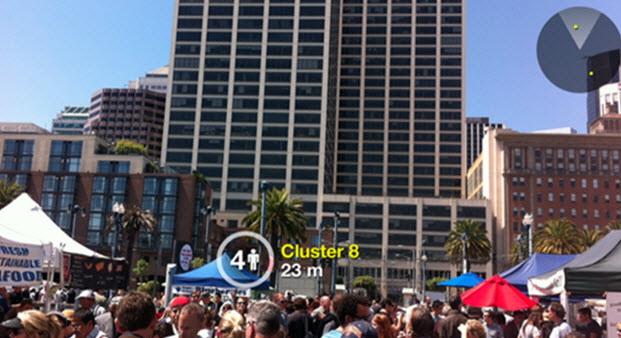New ‘visual breadcrumbs’ smartphone/Glass app maps group exploration paths
August 19, 2013 by Amara D. Angelica

In this iPhone/Glass screen shot taken at a recent event near the San Francisco Ferry Building, four users are looking at the same point (a tented pavilion 23 meters away from this user) (credit: CrowdOptic)
CrowdOptic plans to announce Monday a new mapping technology that will allow users of electronic devices (such as smartphones and Google Glass) to create and share “visual breadcrumb” trails to find each other, CrowdOptic CEO Jon Fisher told me in an exclusive interview.
As KurzweilAI noted on August 3, CrowdOptic’s “find friend” augmented-reality app overlays an object showing what two or more users are looking at when using Google Glass (or aiming their phones).
Now, in a research collaboration with Carnegie Mellon University, CrowdOptic has taken this technology a big step further by adding “visual breadcrumbs” — creating a trace of the path taken by clusters (groups) of explorers.
Based on recorded GPS data, the breadcrumbs show where the users were looking during a particular exploration path.

This map, displayed on a smartphone or Google Glass, shows the path of a group (“8” refers to the eighth group involved in the exploration), ending up at an event just off The Embarcadero in San Francisco (credit: CrowdOptic)
“Wearable devices are going to change the way people interact with maps,” CrowdOptic CEO Jon Fisher explained to me.
“Routes and directions can now be delivered visually to literally point the way and they can continually adjust in real time to always reflect the safest, most efficient path.”
Powerful tool for managing groups
Here’s why I think this could be a real game-changer. The breadcrumbs plot shows exactly what areas a group (and other groups) has already explored so far.
This is important information, for example, in managing search and rescue operations — such as for a lost child or earthquake victim.
And an incident commander of a first-responder team (police, fire, Secret Service) wearing Glass would acquire a powerful new tool for mission control (e.g., knowing where firefighters have just been and warning them of an approaching blaze).
This also allows for increased privacy for the user because the group focus is important, not the individual’s location.
The new tech also includes a “radar” tool, shown in the upper right corner of the smartphone or Glass, that provides a big-picture view.

CrowdOptic “radar” tool (credit: CrowdOptic)
It shows where the current group is looking (the yellow dot in the slice); and where other groups are looking (the lower yellow dot shows another group located behind the user):
CrowdOptic has patented the technology (U.S. Patent No. 8,527,340) that captures these dynamic shifts in where people are looking through their electronic devices, like Google Glass.
The technology will also allow friends to share their routes with each other, especially in complex multi-building environments such as universities (think: Stanford) or shopping malls, and allow people to reroute themselves in response to changing environmental conditions and the paths of other users.
Fisher said CrowdOptic envisions being able to power additional future apps that can lead people to locations where groups are congregating, news is breaking, or friends are meeting.
UPDATE 8/19/.2013: Carnegie Mellon University added as collaborating university